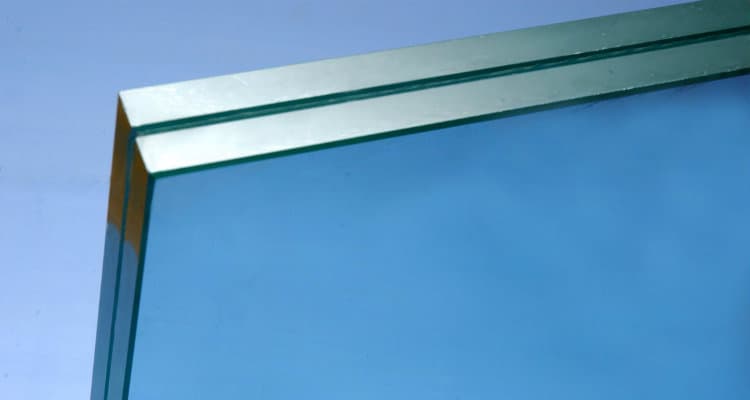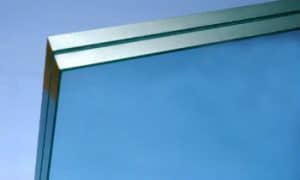I wanted to build a professional vocal booth that looked as good as it sounded. While researching to figure out what kind of window I wanted to use, I realized a single glass pane might not cut it. This got me wondering, does laminated glass reduce noise?
Laminated glass offers superior noise reduction when compared to regular glass. It is comprised of three layers bonded together. Two outer layers of glass surround the center layer of special adhesive. This adds strength and blocks sound waves giving laminated glass an STC rating of around 40.
Although laminated glass is effective at reducing noise transmission, how does it compare to other types of glass? Does it have any drawbacks? What is laminated glass anyway? Let’s take a closer look at laminated glass and its acoustic properties.

How is Noise Reduction Measured in Glass?
Sound Transmission Class (STC) ratings are a measure of the noise reduction abilities of different materials, including glass. The higher a product’s STC rating, the better it is at blocking noise.
Most standard walls will rate between 35-45 STC. The average STC rating for a single pane of regular glass is about 27. A soundproof window will fall into the range of 48-54.
Depending on the thickness and choice of adhesive, it is not uncommon for laminated glass to reach STC levels of even higher than 40. Double-glazed glass has a similar STC rating with better insulating properties. However, it is much more expensive as well.
For most business settings such as offices and workspaces, an STC in the mid-thirties is sufficient. Soundproof professional recording studios would use glass that is rated STC 45+.
What is Laminated Glass?
In laminated glass, the core is made of a special adhesive such as PolyVinyl Butyral (PVB) or Ethylene Vinyl Acetate (EVA). These materials offer superior noise reduction on their own, which is improved further by the addition of a piece of glass on each side.
Laminated glass is a type of safety glass. This safety glass will crack and spiderweb instead of shattering when it is broken. It is held together by the adhesive layer that is sandwiched between the outer two pieces of glass.
Although laminated glass is not bullet-proof, bullet-proof glass is a type of laminated glass. To create bullet-proof glass, polycarbonate, thermoplastic materials, and thermoset EVA are added to layers of laminated glass.
What is Acoustic Laminated Glass?
Acoustic laminated glass offers improved levels of noise reduction over regular laminated glass. To achieve this, several methods are employed.
The panes of glass used can be glazed, essentially combining double glazed and laminated glass. Since each of these types of glass is already highly rated for blocking noise, when combined, the effect is increased. By double glazing the laminated glass, you also give the glass better insulation properties, which laminated glass is lacking.
Air space may also be left to maximize sound blocking characteristics. This space gives the sound waves room to deplete their energy inside of the windowpane. This will result in an even better reduction of noise coming through the glass.
Additionally, the pieces of glass used, the laminate between, or both could all be increased in thickness. By adding more material and making the final product thicker, you can block out more of the sound waves, resulting in decreased noise transmission.
With acoustic laminated glass, STC ratings of over 50 have been achieved. Glass with ratings this high is custom ordered and generally found only in very high-end professional recording studios.
How Can You Tell If Glass Is Laminated?
One surefire way to tell if your glass is laminated or not is to break it and see if it shatters! Of course, if you do this, you cannot use that piece anymore. Probably not the most efficient way to test this. So how else can you tell?
If you hold the glass on its side and look at the edge, you will be able to tell if it is laminated glass. Because laminated glass has layers, when you observe the edge, you will be able to see those layers, identifying the piece as laminated glass.
If you have an ear for it, you can actually hear the difference between laminated glass and other types when tapped on! You’d have to know already the difference in sound to use this method, so it’s more of a novelty than anything.
If you want to know whether your vehicle’s windshield is laminated or not, the method for doing so is a bit different. Check out this article to learn how to tell if your car’s windshield is laminated.
Where Can Laminated Glass Be Used?
Because of its high strength and ability to resist shattering, laminated glass is used where impact is likely. Automobile windshields are manufactured out of laminated glass.
Laminated glass is also used anywhere there is a risk of the glass falling if it were broken. Skylights in a roof must be made from laminated glass for this reason.
Laminated glass is also often used in exterior applications in locations where hurricanes are a concern. In these areas, laminated glass may be used in windows, curtain walls, and storefronts.
For security applications such as windows and doors, laminated glass is often used due to it’s high strength and resistance to shattering. Tempered glass can also be used in these applications. Laminated glass is stronger and blocks UV light, but tempered glass is much cheaper.
Acoustic Properties of Laminated Glass
Most laminated glass will have an STC rating of around 40. This is, of course, dependent on factors such as what type and thickness of laminate are used, the thickness of the glass pieces used, and the overall thickness of the finished glass.
In laminated glass, it is the adhesive layer in the middle that does a majority of the noise reduction. By increasing the size of this layer, better noise reduction can be achieved. Laminated glass reduces noise transmission nearly as well as acoustic glass which is much more expensive.
Benefits of Laminated Glass
Laminated glass possesses a whole host of benefits. Some of the most noteworthy are:
- Very high strength means it is impact resistant.
- Safety glass doesn’t shatter when broken.
- Excellent noise reduction characteristics.
- Blocks 99% of UV light which can help stop carpets and upholstery from fading.
- It can be repaired from minor impact damage.
Drawbacks of Laminated Glass
Although it has many positive qualities, laminated glass has its limitations also:
- Low insulation properties.
- Not suitable as sole glass in exterior windows.
- Expensive compared to regular glass.
- It is difficult to cut due to the adhesive layer in the core.
How Secure is Laminated Glass?
Because it is so strong and is rated as safety glass, laminated glass is often used in security installations. It would be very difficult to fully break through a piece of laminated glass. It would take at least two strong hits with a hammer to break through.
Laminated glass is designed to flex before it breaks. This is why car windshields do not always break in the case of an accident.
How Much Does Laminated Glass Cost?
The price of laminated glass can vary greatly depending on several factors such as:
- Size of glass needed
- Manufacturer used
- Thickness of glass
- Type of adhesive layer used
During my research, I was looking for a piece that was a 24” square. The biggest determining factor on the price that I found was the overall thickness of the finished piece of glass. For a ¼” piece at this size, the price was just over $200. For a 1” thick piece of the same size, the price was just under $500. For more information on pricing, check out this site.
Conclusion
Laminated glass has many characteristics that make it superior to regular glass. The excellent noise reduction of laminated glass makes it a great choice when sound transmission is a concern.
Please feel free to share this article with others who may need the information it contains. If you have any questions or comments, please leave them below in the comments section. It’s much appreciated!


Thanks Eugene for a very informative article. What are your thoughts on acrylic? I’m wanting to have interior windows built in my condo (which is next to a busy highway) and choosing between acrylic and laminated glass. Not sure which is more soundproof?
Hello Eugene.
My contractor propose me a laminate 8+pvb+8.
I was wondering if having different thickness would not be more effective, for example 8+pvb+6. what is your opinion ?
thank you
Ben
HI Eugene,
Thank you for the excellent information comparing laminated glass to plexiglass. We live in a large city and are dealing with a lot of traffic and construction noise. I’m in the process of researching window inserts and that is how I came across your site. I’m leaning towards laminated glass inserts manufactured by Sun and Sound Windows, a local company here in Houston. Do you have any advice or words of wisdom to help me in my search for a product to help reduce the noise level in my home?
Hi Cathy,
In my experience, an insert window leaves the existing frame, brickmould, and casing, and a smaller unit is fit inside that opening. I am not a fan of that, because it will not address the insulation (or lack of insulation) around the perimeter of the frame. Good insulation will not only keep out heat and cold, but will help with soundproofing. Other than the glass, you might want to look at AcousticCurtain by Residential Acoustics or ShutEye Acoustical Shutters by Quietly Making Noise.
Hope that helps,
Terry
Hey Eugene,
I install windows for a living and definently agree that laminated glass is very high strength means it is impact resistant. It is good insight.
Hi Zach,
Thanks for the comment. I also installed windows for a living–since before the invention of dirt. Pretty good way to make a living–as long as the body holds up.
Terry
Hi, I am in the processing of looking to replace my dual pane windows with noise-reduction windows. Is double laminated glass better than 2 glasses of varying thickness w/ one of the pieces being laminated?
Hi LL,
Yes double laminated glass provides better soundproofing.
Terry
As someone who makes their profession installing windows, I can attest to the fact that the laminated variety is significantly more resilient to the effects of impact. This is a very insightful observation.
I agree that the high strength of laminated glass makes it resistant to impact; this is my line of work. It’s a wise observation.